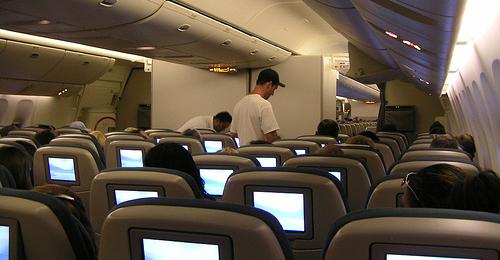B-B-B-Bennie (A Question Of Safety)

This is actually a question, but I’m going to phrase it in the form of a bit of imagineering:
It’s the future, but not by much, and you’re in a passenger jet.
Despite the fact that you’ve heard the instructions a hundred times previous, you’ve been a good customer and listened to the safety talk at the start of the flight – even though it meant having to strain to hear over the pair of teenage brothers arguing for the window seat in the next row. You’re feeling this was an especially good idea, as the tinny voice of the Captain has recently broken out from the speakers to inform you that the plane is currently suffering some technical issues.

Your suspicions that it might have something to do with the flaming engine on the left wing are well founded.
The harness you’ve buckled yourself into was a little unwieldy, but the low chime the jet’s computer made to indicate you’d done it properly was actually oddly soothing. The flight attendants continue to coo for everyone to remain calm, but you can’t stop staring at the roasting wing, and thinking about the first episode of LOST.
Without warning, the plane starts to lose altitude.
Thrashing your head around, you note that smoke is now also billowing from the opposite side of your conveyance.
For a brief moment, vocal anarchy breaks out. You can hear the teenage boys shrieking, even over the cacophony of sudden cursing and prayer, and your mind goes into a red panic at the idea that this might be your last breath.
In fact, the only thing that isn’t alarmed is the central brain, nicknamed Bennie, that the folks at Boeing have programmed and prepared for just such a situation. The machine doesn’t care if it’s narcing on bathroom smokers or preparing for a crash, it purrs along, unaffected. It runs some equations and decides that a proper landing is now impossible.
[youtube=http://www.youtube.com/watch?v=QjUk3Bp16zs]
Long seconds into the drop, there’s a quick series of pops, and a strip of roof running the length of the jet catches the wind and blows away, exposing the blue sky and clouds above.
The fluffy white puffs seem to be moving upwards at a terrible speed.
At 30,000 feet the seats start flying. The rapid fire process could never be controlled by a human hand, but Bennie has no issues with the micro-timing required to prevent mid-air impacts during the departures. By the 15,000 foot mark the tube is an empty egg carton, and the wind is full of parachutes.
You, the seat your buckled to, and your similarly situated fellow passengers, all begin the slow descent to the farmland below, feeling like the world’s laziest paratrooper invasion.
The plane’s final impact is spectacular, and your view of it will remain in your memory for the rest of your life.
Now, my question – why not?
Because the system would add weight to the plane, thus increasing fuel use. Because it would need to be maintained and certified, thus requiring additional labor and bureaucracy. Fuel, labor and bureaucracy cost money, and airlines run on a narrow margin.
And because not every precaution is worth the money it costs to implement it.
Hmm, this all sounds depressingly like the insurance-equation discussion from Fight Club. We can insert per-seat video displays, but we can’t implement safety measures?
I wonder what the family payoffs are like when a full load of passengers plow into a cow pasture at 250 m/s.
Same problem I had with the robot lifeguard. Certain situations need human intuition, experience, and skill. This would be great if used alonside a pilot or as a backup.
True – having the system suddenly pull a false alarm and empty the jet at 45,000 feet would definitely be a problem.
More or less on topic, this reminds me of the debate over surgeons who only train on computer simulations or phony synthetic operation dummies. I wouldn’t use a surgeon who never operated on a real human. Too many oddities occur in the bodies, too many unforeseen problems, and even the fact that a person will react very differently when doing a procedure on what he knows to be a model as opposed to what he knows to be a person.
Yeah, agreed. I don’t think we can build a robot with quite the right squish and spurt to really properly replicate the oddities of the human system – but, at the same time, I think in twenty years the technology that will have branched out of those schools of practice will blow our 2011 minds.